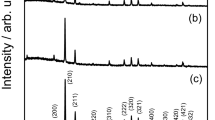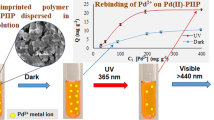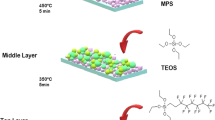Abstract
Selective deposition of SiO2 nanoparticles was demonstrated on a soda-lime glass surface with a periodic sodium deficient pattern formed using the electrical nanoimprint. Positively charged SiO2 particles generated using corona discharge in a cyclic siloxane vapor, were selectively deposited depending on the sodium pattern. For such phenomena to occur, the sodium ion migration to the cathode side was indispensable to the electrical charge compensation on the glass surface. Therefore, the deposition proceeded preferentially outside the alkali-deficient area. Periodic SiO2 structures with 424 nm and 180 nm heights were obtained using one-dimensional (6 μm period) and two-dimensional (500 nm period) imprinted patterns.
Similar content being viewed by others
Introduction
Fabrication of fine structures on oxide glass surfaces is attracting great attention for highly functional and reliable optics. Recently, thermal nanoimprinting has become used for the fabrication of fine structures on several oxide glasses1,2,3,4. However, the mold lifetime is insufficient because of the high process temperature. Xerography-like deposition has also been used for the periodical arrangement of nanoparticles5,6,7. Particles immersed in a solution can be patterned on the locally charged surface of the substrate. Electrospray deposition has also been studied for micropattern formation8,9,10. Despite benefits such as high throughput and wide-area patterning, these processes are disadvantageous for fabricating structures with a high aspect ratio, such as those required for microwavelength and sub-microwavelength optics, such as high spatial frequency gratings11, phase control plates12, anti-reflective lenses13,14 and strong plasmon coupled gratings15.
As described in this report, we propose a selective deposition method of SiO2 using a corona discharge for electrically imprinted soda-lime glass. The corona discharge is generated at the anode electrode with high voltage16,17,18,19, where the generated charged ion or particles are accelerated to the cathode electrode.
The electrical imprint can form fine structures on alkali-containing glasses at lower temperatures than those for thermal nanoimprinting20,21. The origin of structure formation is the diffusion of alkali ions in the glass from the anode side to the cathode side, depending on the mold pattern, which is similar to alkali ion behavior that occurs during thermal polling processing22,23,24,25. Using these two processes, we fabricated fine structures on soda-lime glasses at low temperatures and ambient pressures.
Results
Selective deposition
Figure 1(c,d) show atomic force microscope (AFM, Nanocute; SII Nanotechnology Inc.) views of the surface profiles on the specimens electrically imprinted with the molds of two types: mold A, one-dimensional with a 6 μm period and mold B, two-dimensional with a 500 nm period as shown in Fig. 1(a,b). Shallow concavities were formed on the glass surface after the electrical imprint applying +200 V. The formation mechanism of concavities was reported in our previous paper21. Figure 1(e,f) present surface profiles after the corona discharge treatment by an application of +6 kV to the needle electrode for 60 min at 200 °C in air containing vaporized cyclic siloxane. The structure height on substrates imprinted under +200 V increased efficiently after the corona discharge without deviation of periods. The maximum heights were 175 nm for the one-dimensional pattern and 157 nm for the two-dimensional pattern.
AFM views of molds (upper), glass surfaces after electrical imprint applying +200 V (middle) and after corona discharge in air containing cyclic siloxane vapor (lower): (a) mold A, one-dimensional with a 6 μm period; (b) mold B, two-dimensional with a 500 nm period; (c,d) respectively show the imprinted surfaces using molds A and B; (e,f) respectively show after corona discharge using imprint substrate (c,d).
Chemical composition of the deposited area after the corona discharge treatment was analyzed using an X-ray photoelectron spectrometer (XPS) combined with C60 ion sputtering, as shown in Fig. 226. Although a trace amount of carbon contamination from ambient was detected on the top surface, the main material was SiO2. In contrast, the SiO2 deposition on the glass was never recognized during the corona discharge treatment in an ambient air. Therefore, these results suggest that the vaporized cyclic siloxane was decomposed by the corona discharge plasma and that it was deposited on the glass surface as SiO2.
Mechanism of selective deposition
The next topic of interest is the selective deposition mechanism of SiO2 only on the electrically imprinted glass surface after the application of a positive voltage. Figure 3 presents an enlarged AFM view of the glass surface after the electrical imprint with +200 V using mold B (see Fig. 1(b)) followed by the corona discharge in cyclic siloxane vapor for 30 min at 200 °C. Deposition occurred clearly on the outside of the applied voltage area.
Stemmer et al.5 and Okuyama et al.9 respectively reported the selective deposition of silica nanoparticles on a substrate with a patterned surface charge using xerography-like deposition and electrospray deposition. They attributed the origin of selective deposition to the electrostatic attractive force between charges localized on a substrate and on the particles. In order to confirm the origin of the selective deposition, we investigated the surface charge on the electrically imprinted glass using a Kelvin force microscope (KFM, Nanocute; SII Nanotechnology Inc.). However, the measurement noise of KFM was larger than the expected surface charge. Furthermore, the selective chemical vapor deposition could not be confirmed on the glass after electrical imprinting with negative voltage. Therefore, no relation is expected to exist between the surface charge and the selective chemical vapor deposition. Instead, a plausible origin of the selective corona discharge deposition is the formation of pattern with different ion conductivity by the electrical imprint. Then the cross-sectional image of the glass was observed after the electrical imprint with +200 V using mold A. Figure 4(a) portrays the surface profile observed using a scanning electron microscope (SEM, JSM-6510A, JEOL Ltd.). It was hard to recognize the periodic concavo-convex structure on the surface. However, as shown in Fig. 4(b), there was a periodic sodium deficient pattern of 400 nm deep remained in the area contacted with the mold, which was analyzed using a time-of-flight secondary ion mass spectrometer (ToF-SIMS, TOF.SIMS5; ION-TOF GmbH Inc.) with C60 ion sputtering27.
Enami et al. reported that the conductivity of sodium depletion area was decreased by five orders of magnitude (from 10−10 to 10−15 S) at 180 °C compared with that of the pristine glass, which means that there is a pattern of ion conductivity depending on the sodium concentration24. On the other hand, the corona discharge plasma decomposes the cyclic siloxane vapor to a positively charged species, which is accelerated in the cathode direction and which is deposited selectively on the ion conductive area, i.e., a sodium ion area. The importance of the ion conductivity for the glass substrate can be demonstrated by the following experiment using two glasses with different conductivities. Namely, during the corona discharge treatment, the half area of soda-lime glass was covered with a dehydrated synthetic fused silica glass plate with a negligibly low ion conductivity. In consequence, the SiO2 deposited only on the soda-lime glass surface. Details were described in the Supplementary Information. Based on the considerations presented above, the selective deposition of SiO2 can be described as portrayed in Fig. 5(a).
Deposition characteristics
Figure 6 shows the relation between the selective deposition time and the structural height when the corona discharge condition was +6 kV applied voltage at 200 °C. The maximum heights increased up to 424 nm and 180 nm for molds A and B, respectively. The heights decreased with the deposition time after their peak times. The selectivity of the deposition degraded with the deposition time gradually and the grooves were filled by the SiO2 after the prolonged corona discharge treatment. The degradation of selective deposition should be caused by the equalization of surface ion conductivity because of the migration of remaining sodium ions in the electrically imprinted soda-lime glass to the cathode side as shown in Fig. 5(b). Therefore, the optimization of electrical imprint and corona discharge conditions, deposition species and substrate composition might realize the rapid formation of fine structures with a high aspect ratio.
Conclusions
We proposed the fabrication process for fine structures using corona discharge selective chemical vapor deposition of SiO2 onto an electrically imprinted soda-lime glass surface. Sodium in the surface area of the glass contacted with the mold migrated to the cathode side using the electrical imprint. The vaporized cyclic siloxane was decomposed to positively charged silicon oxide by the corona discharge plasma, which were deposited selectively as SiO2 onto the sodium ion area on the soda-lime glass because of the high ion conductivity. The maximum structure heights were 424 nm and 180 nm for a one-dimensional mold with a 6 μm period and a two-dimensional mold with a 500 nm period, respectively. These SiO2 structures can be formed at 200 °C under the ambient pressure. A contrast of the ion conductivity in the glass determines the aspect ratio of the selective deposition structures. Furthermore, the optimization of the deposition condition might include factors such as the chemical composition of the glass, the vaporization source and the state of ionization. Their optimization is expected to enable the production of the desired fine SiO2 structures for use in highly functional and reliable next-generation optics.
Methods
Commercially available soda-lime glass (Tg = 555 °C) of 10 mm × 10 mm × 1 mm was used for the substrate. The electrical imprint setup is presented in Fig. 7(a). In this work, SiO2 molds of two types were prepared using conventional photolithography and dry etching. The mold surface was coated with 40-nm-thick carbon by sputtering to maintain its electrical conductivity. The mold was then set in the electrical imprint machine and was connected with the DC power supply (Series EH; Glassman High Voltage Inc.). The glass sample fixed on the grounded stage was imprinted by the carbon-coated-mold at 3 MPa in pressing load, 450 °C for 180 s in N2 atmosphere. Then +200 V was applied to the mold during imprinting.
The electrically imprinted glass was subjected to corona discharge treatment in air containing cyclic siloxane vapor. Figure 7(b) shows the fundamental setup for the corona discharge treatment. A nickel-coated steel needle and an aluminum plate were set, respectively, in the electric furnace (FO200; Yamato Scientific Co. Ltd.) as anode and cathode electrodes. These electrodes were connected to a DC power supply (AKTB-010K1P; Towa Keisoku Co. Ltd.). The electrically imprinted glass sample was placed on the cathode electrode. The distance between the anode tip and the glass top surface was fixed at 10 mm. An adhesive of heat-resistant tape (Nitoflon Adhesive Tape No. 903UL, volatilization of adhesive: >180 °C; Nitto Denko Corp.) was used as the source of cyclic siloxane vapor in the chamber. The corona discharge was generated by an application of +6 kV at 200 °C in air containing cyclic siloxane vapor.
Additional Information
How to cite this article: Sakai, D. et al. Selective Deposition of SiO2 on Ion Conductive Area of Soda-lime Glass Surface. Sci. Rep. 6, 27767; doi: 10.1038/srep27767 (2016).
References
Hirai, Y., Kanakugi, K., Yamaguchi, T., Yao, K., Kitagawa, S. & Tanaka, Y. Fine pattern fabrication on glass surface by imprint lithography. Microelectron. Eng. 67–68, 237–244 (2003).
Saotome, Y., Imai, K. & Sawanobori, N. Microformability of optical glasses for precision molding. J. Mater. Process. Technol. 140, 379–384 (2003).
Yamada, K., Umetani, M., Tamura, T., Tanaka, Y., Kasa, H. & Nishii, J. Antireflective structure imprinted on the surface of optical glass by SiC mold. Appl. Surf. Sci. 255, 4267–4270 (2009).
Tamura, T., Umetani, M., Yamada, K., Tanaka, Y., Kintaka, K., Kasa, H. & Nishii, J. Fabrication of Antireflective Subwavelength Structure on Spherical Glass Surface Using Imprinting Process. Appl. Phys. Exp. 3, 112501 (2010).
Mesquida, P. & Stemmer, A. Attaching Silica Nanoparticles from Suspension onto Surface Charge Patterns Generated by a Conductive Atomic Force Microscope Tip. Adv. Mater. 13, 1395–1398 (2001).
Naujoks, N. & Stemmer, A. Using local surface charges for the fabrication of protein patterns Coll. Surf. A 249, 69–72 (2004).
Naujoks, N. & Stemmer, A. Micro- and nanoxerography in liquids – controlling pattern definition. Microelectron. Eng. 78–79, 331–337 (2005).
Morozov, N. V. & Morozova, Y. T. Electrospray Deposition as a Method for Mass Fabrication of Mono- and Multicomponent Microarrays of Biological and Biologically Active Substances. Anal. Chem 71, 3110–3117 (1999).
Lenggoro, W. I., Lee, M. H. & Okuyama, K. Nanoparticle assembly on patterned “plus/minus” surfaces from electrospray of colloidal dispersion. J. Colloid Interface Sci. 303, 124–130 (2006).
Jaworek, A. & Sobczyk, T. A. Electrospraying route to nanotechnology: An overview. J. Electrostat. 66, 197–219 (2008).
Nishii, J., Kintaka, K. & Nakazawa, T. High-efficiency transmission gratings buried in a fused-SiO2 glass plate. Appl. Opt. 43, 1327–1330 (2004).
Kikuta, H., Ohira, Y. & Iwata, K. Achromatic quarter-wave plates using the dispersion of form birefringence. Appl. Opt. 36, 1566–1572 (1997).
Toyota, H., Takahara, K., Okano, M., Yotsuya, T. & Kikuta, H. Fabrication of Microcone Array for Antireflection Structured Surface Using Metal Dotted Pattern. Jpn. J. Appl. Phys. Part 2 40, L747–L749 (2001).
Tamura, T., Umetani, M., Yamada, K., Tanaka, Y., Kintaka, K., Kasa, H. & Nishii, J. Fabrication of Antireflective Subwavelength Structure on Spherical Glass Surface Using Imprinting Process. Appl. Phys. Exp. 3, 112501 (2010).
Cui, X. Q., Tawa, K., Hori, H. & Nishii, J. Duty ratio-dependent fluorescence enhancement through surface plasmon resonance in Ag-coated gratings. Appl. Phys. Lett. 95, 133117 (2009).
Munakata, K., Harada, K., Anji, H., Itoh, M., Yatagai, T. & Umegaki, S. Diffraction efficiency increase by corona discharge in photoinduced surface-relief gratings on an azo polymer film. Opt. Lett. 26, 4–6 (2001).
Sakai, D., Harada, K., Kamemaru, S. & Fukuda, T. Hologram replication technique in glass plates using corona charging. Appl. Phys. Lett. 90, 061102 (2007).
Sakai, D., Harada, K., Kamemaru, S., Barada, D., Sato, F. & Fukuda, T. Recording Characteristics of Hologram in Glass Plate Using Corona Charging. Jpn. J. of Appl. Phys. 47, 7929–7931 (2008).
Ikeda, H., Sakai, D., Funatsu, S., Yamamoto, K., Suzuki, T., Harada, K. & Nishii, J. Generation of alkali-free and high-proton concentration layer in a soda lime glass using non-contact corona discharge. J. Appl. Phys. 114, 063303 (2013).
Takagi, H., Miyazawa, S., Takahashi, M. & Maeda, R. Electrostatic Imprint Process for Glass. Appl. Phys. Exp. 1, 024003 (2008).
Ikutame, N., Kawaguchi, K., Ikeda, H., Sakai, D., Harada, K., Funatsu, S. & Nishii, J. Low-temperature fabrication of fine structures on glass using electrical nanoimprint and chemical etching. J. Appl. Phys. 114, 083514 (2013).
Krieger, K. U. & Lanford, A. W. Field Assisted Transport Of Na+ Ions, Ca2+ Ions And Electrons In Commercial Soda-Lime Glass I: Experimental. J. Non-Cryst. Solids 102, 50–61 (1988).
Lepienski, M. C., Giacometti, A. J., Ferreira, L. F. G., Freire, L. F., Jr. & Achete, A. C. Electric field distribution and near-surface modifications in soda-lime glass submitted to a dc potential. J. Non-Cryst. Solids 159, 204–212 (1993).
Enami, Y., Poyhonen, P., Mathine, L. D., Bashar, A., Madasamy, P., Honkanen, S., Kippelen, B., Peyghambarian, N., Marder, R. S., Jen, K.-Y. A. & Wu, J. Poling of soda-lime glass for hybrid glass/polymer electro-optic modulators. Appl. Phys. Lett. 76, 1086–1088 (2000).
Dussauze, M., Rodriguez, V., Lipovskii, A., Petrov, M., Smith, C., Richardson, K., Cardinal, T., Fargin, E. & Kamitsos, I. E. How Does Thermal Poling Affect the Structure of Soda-Lime Glass ? J. Phys. Chem. C 114, 12754–12759 (2010).
Yamamoto, Y. & Yamamoto, K. Precise XPS depth profile of soda-lime-silica glass using C60 ion beam. J. Non-Cryst. Solids 356, 14–18 (2010).
Kobayashi, D., Yamamoto, Y. & Isemura, T. Time-of-flight SIMS depth profiling of Na in SiO2 glass using C60 sputter ion beam. Surf. Interface Anal. 45, 113–116 (2013).
Acknowledgements
This work was performed under the Cooperative Research Program of the “Network Joint Research Center for Materials and Devices” by the Ministry of Education, Culture, Sports, Science and Technology (MEXT), Japan. A part of this work was supported by JSPS KAKENHI “Grant-in-Aid for Young Scientists (B)” Grant Number JP 15K18228 by Japan Society for the Promotion of Science (JSPS), Japan.
Author information
Authors and Affiliations
Contributions
D.S., K.H. and J.N. conceptualized the idea. D.S. wrote the main manuscript text. H.I., H.K. and J.N. assisted construction of the manuscript text. D.S., Y.H., N.I. and K.K. conducted the experiments. T.S., Y.Y. and K.Y. analyzed the results. S.F., K.U. and J.N. supervised this research. All authors reviewed the manuscript.
Ethics declarations
Competing interests
The authors declare no competing financial interests.
Electronic supplementary material
Rights and permissions
This work is licensed under a Creative Commons Attribution 4.0 International License. The images or other third party material in this article are included in the article’s Creative Commons license, unless indicated otherwise in the credit line; if the material is not included under the Creative Commons license, users will need to obtain permission from the license holder to reproduce the material. To view a copy of this license, visit http://creativecommons.org/licenses/by/4.0/
About this article
Cite this article
Sakai, D., Harada, K., Hara, Y. et al. Selective Deposition of SiO2 on Ion Conductive Area of Soda-lime Glass Surface. Sci Rep 6, 27767 (2016). https://doi.org/10.1038/srep27767
Received:
Accepted:
Published:
DOI: https://doi.org/10.1038/srep27767
Comments
By submitting a comment you agree to abide by our Terms and Community Guidelines. If you find something abusive or that does not comply with our terms or guidelines please flag it as inappropriate.










